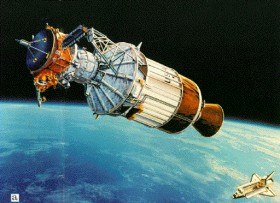|
ULYSSES
The Solar Polar Mission
Mission Overview
 The Ulysses mission is unique in the history of the exploration of our solar
system by spacecraft. Its orbit enabled the
scientists, for the first time,
to explore the heliosphere within 5 astronomical units of the Sun over all
heliospheric latitudes. This provides the first characterisation of the third
heliospheric dimension. Highly sophisticated scientific instruments carried on
board the spacecraft are designed to measure the properties of the solar wind,
the heliospheric magnetic field, solar radio bursts and plasma waves, solar
X-rays, solar and galactic cosmic rays, and interplanetary/interstellar neutral
gas and dust. Ulysses detected cosmic gamma-ray bursts and searches also for
gravitational waves. The mission is a collaboration between ESA and NASA.
The Ulysses mission is unique in the history of the exploration of our solar
system by spacecraft. Its orbit enabled the
scientists, for the first time,
to explore the heliosphere within 5 astronomical units of the Sun over all
heliospheric latitudes. This provides the first characterisation of the third
heliospheric dimension. Highly sophisticated scientific instruments carried on
board the spacecraft are designed to measure the properties of the solar wind,
the heliospheric magnetic field, solar radio bursts and plasma waves, solar
X-rays, solar and galactic cosmic rays, and interplanetary/interstellar neutral
gas and dust. Ulysses detected cosmic gamma-ray bursts and searches also for
gravitational waves. The mission is a collaboration between ESA and NASA.
Within the project, the responsibilities for Ulysses mission operations
have been defined as follows:
-
NASA launched the spacecraft and provided telemetry acquisition, tracking, and command transmission through its DSN ground stations.
-
ESA provided data processing for spacecraft control, spacecraft manoeuvring, and scientific quick-look data examination, and provide spacecraft control personnel to control the mission from the JPL Misssion Operations Centre in Pasadena.
The Ulysses spacecraft was launched on October 6,
1990 by means of the NASA Space Shuttle "Discovery", using a Centaur
upper-stage motor to inject the spacecraft into an ecliptic transfer orbit.
The spacecraft arrived at Jupiter 14 months after launch, passed by the planet
slightly above its equatorial plane. The Jovian gravitational field deflected
the spacecraft into a high-inclination orbit,
taking it south of the ecliptic plane. The elliptical out-of-ecliptic
trajectory, which has aphelion near 5.3 AU and perihelion near 1.3 AU, is such
that, 2.5 years after Jupiter encounter, the spacecraft passed over the
southern solar polar region at a distance 2 AU above the ecliptic. Following
this polar passage, it then crossed the plane of the ecliptic, and headed for
a pass over the north polar region eight months after the first. The maximum
latitude was limited to 80 degrees due to the rquirement, that it should not
pass Jupiter closer than 6 RJ in order to avoid the high radiation fields
nearer to the planet. All hardware was designed to withstand the radiation
dose accumulated during the Jupiter flyby.
![[Top]](/images/icons/top.gif)
The Ulysses Spacecraft
The Ulysses spacecraft is
dominated by the large-diameter (1.65 m), parabolic,
High-Gain Antenna providing the communication link to Earth. The second
prominent feature of the spinning
spacecraft (5 rpm) is the Radioisotopic Thermoelectric Generator (RTG)
supplying
the spacecraft's electrical power. This design
is necessary because of the long distances from the Earth and the Sun at which
the
spacecraft is operating. Experiment requirements for electromagnetic
cleanliiness and for minimisation of the RTG radiation environment
resulted in a 5.6 m-long radial boom. It carries several experiment sensors
and is mounted on the side of the spacecraft opposite to the RTG. A 72 m
tip-to-tip dipole wire boom and a 7.5 m axial boom serve as electrical antennas
for the Radio and Plasma-Wave Experiment. Most scientific instruments are
mounted on the main body, as far as possible removed from the RTG, and in
compliance with the field-of-view requirements of the instrument sensors.
The high gain antenna serves as the radio link to Earth with 20 W X-band and 5 W
S-band transmitters. The uplink S-band carries commands and ranging code. The
downlinks in X- and S-band carry telemetry and turnaround ranging,
respectively. This simultaneous ranging and telemetry is a basic feature of
the spacecraft communication system.
At launch Ulysses weighed 366 kg. Spacecraft mass properties and balance have
been a driver in the spacecraft design to meet the requirements both for the
launch configuration (stowed booms) and for deployed boom configuration.
Continuous coverage by ground stations was considered impossible for such a
long-duration mission; therefore data were stored on-board for 16 hours and
replayed, interleaved with real-time data, during 8 hour periods of coverage;
the NASA deep Space Network has been used for commanding and data reception. A
variety of downlink bit rates 128 and 8192 bit/s are selectable. The spacecraft
also provides autonomous system capabilities for failure-mode detection and
for safe spacecraft reconfiguration. This is required during unexpected and/or
predicted periods of nontracking and because of the long signal travel-time
between ground and spacecraft. The preprogrammable functions include
searchmode initiation to reacquire the Earth if no command is received after a
preselectable time up to 30 days, switch-over to redundant units, and
preprogrammed attitude manoeuvres at superior conjunction.
|
|
|
|
|
 |
|
|
|
|
